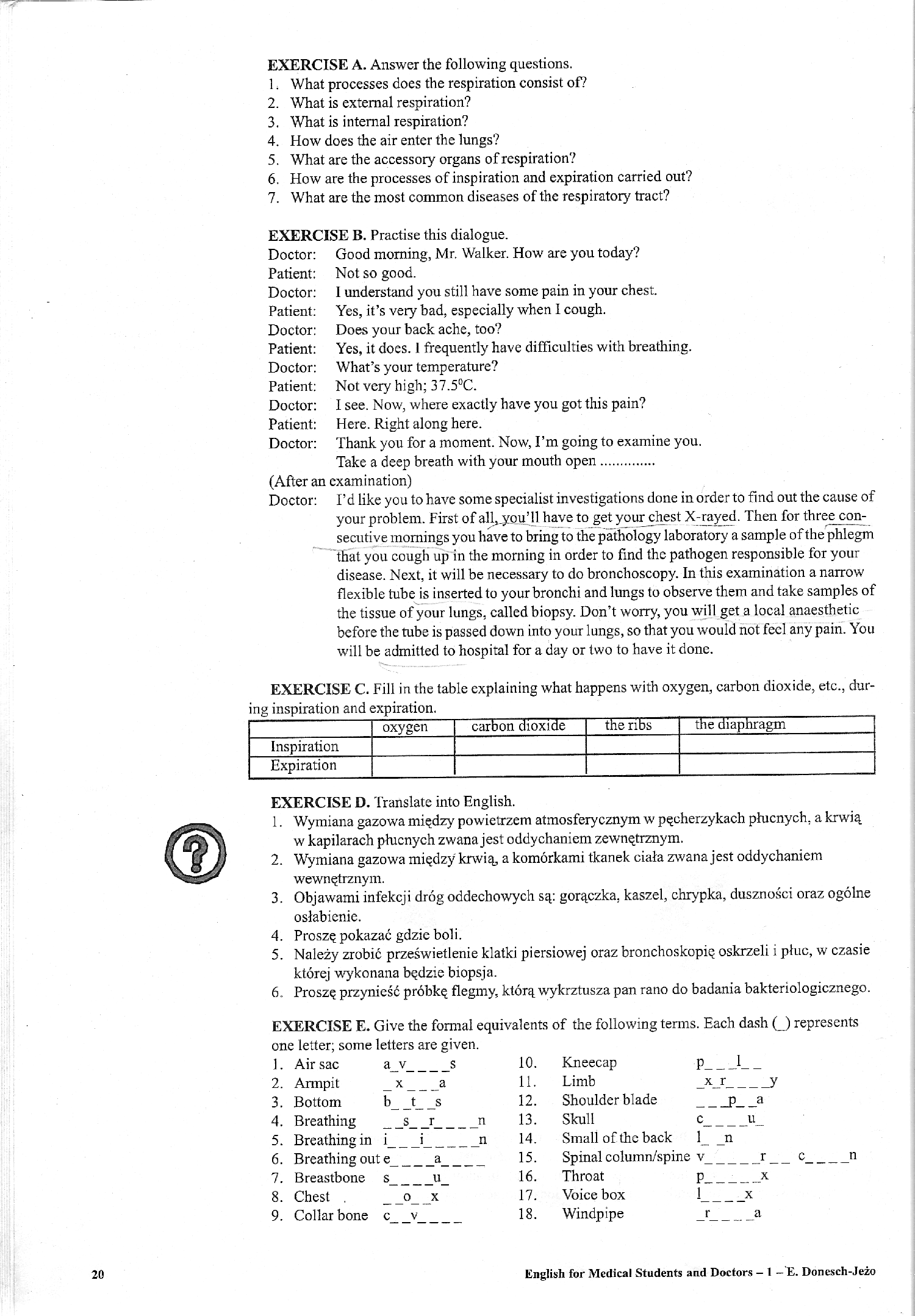20(1)

EXERCISE A. Answer the following ąuestions.
1; What processes does the respiration consist of?
2. What is extemal respiration?
3. What is intemal respiration?
4. How does the air enter the lungs?
5. What are the accessory organs of respiration?
6. How are the processes of inspiration and expiration carried out?
7. What are the most common diseases of the respiratory tract?
EXERCISE B. Practise this dialogue.
Doctor: Good moming, Mr. Walker. How are you today?
Patient: Not so good.
Doctor: I understand you still have some pain in your chest.
Patient: Yes, it’s very bad, especially when I cough.
Doctor: Does your back ache, too?
Patient: Yes, it does. 1 freąuently have difficulties with breathing.
Doctor: What’s your temperaturę?
Patient: Not very high; 37.5°C.
Doctor: I see. Now, where exactly have you got this pain?
Patient: Here. Right along here.
Doctor: Thank you for a moment. Now, I’m going to examine you.
Take a deep breath with your mouth open..............
(After an examination)
Doctor: I’ d like you to have some specialist investigations done in order to fmd out the cause of
your problem. First of all, you’11 have to get yourchest X-rayed. Then for three con-secutiye momings you have to bring to the pathology laboratory a sample of the phlegm "tfiat you cough upin tlie moming in order to find the pathogen responsible for your disease. Next, it will be necessary to do bronchoscopy. In this examination a narrow flexible tubę is inserted to your bronchi and lungs to observe them and take samples of the tissue of your lungs, called biopsy. Don’t worry, you will get a local anaesthetic before the tubę is passed down into your lungs, so that you would not feel any pain. You will be admitted to hospital for a day or two to have it done.
EXERCISE C. Fili in the table explaining what happens with oxygen, carbon dioxide, etc., dur-
ing inspiration and expiration.
|
oxygen |
carbon dioxide |
the ribs |
the diaphragm | |
|
Inspiration | ||||
|
Expiration |
EXERCISE D. Translate into English.
1. Wymiana gazowa między powietrzem atmosferycznym w pęcherzykach płucnych, a krwią w kapilarach płucnych zwana jest oddychaniem zewnętrznym.
2. Wymiana gazowa między krwią, a komórkami tkanek ciała zwana jest oddychaniem wewnętrznym.
3. Objawami infekcji dróg oddechowych są: gorączka, kaszel, chrypka, duszności oraz ogólne osłabienie.
4. Proszę pokazać gdzie boli.
5. Należy zrobić prześwietlenie klatki piersiowej oraz bronchoskopię oskrzeli i płuc, w czasie której wykonana będzie biopsja.
6. Proszę przynieść próbkę flegmy, którą wykrztusza pan rano do badania bakteriologicznego.
EXERCISE E. Give the formal equivalents of the following tenns. Each dash (_) represents
one letter; some łetters are given.
|
1. |
Air sac |
a v |
s |
10. |
Kneecap |
P 1 |
|
2. |
Armpit |
X |
a |
11. |
Limb |
x r ] |
|
3. |
Bottom |
b t |
s |
12. |
Shoulder blade |
_P a |
|
4. |
Breathing |
s |
r n |
13. |
Skuli |
c u |
|
5. |
Breathing in |
i i |
n |
14. |
Smali of the back |
1 n |
|
6. |
Breathing out |
e |
a |
15. |
Spinał column/spine |
v r |
|
7. |
Breastbone |
s |
u |
16. |
Throat |
p X |
|
8. |
Chest . |
0 |
X |
17. |
Voice box |
1 X |
|
9. |
Collar bonę |
c V |
18. |
Windpipe |
_r____a |
English for Mcdical Students and Doctors - 1 — E. Donesch-Jeżo
Wyszukiwarka
Podobne podstrony:
34 EXERCI.SE A. Answer the following ąuestions. 1. What is the function of the uri
EXERCISE A. Answer the folio wing ąuestions. 1. What are the functions ofthe diges
EXERCISE A. Answer the following questions: 1. What are the main parts of the huma
TELEVISION IN GREAT BRITAIN3 EXERCISESI. Answer the ąuestions. 1. Can you describe
20
Level 3 Model ExamLISTENING Description of the Test The test consists of 3 tasks containing 20
Level 3 Model ExamREADING Description of the Test The test consists of 2 tasks and contains 20 quest
Level 3 Model ExamREADING Description of the Test The test consists of 3 tasks containing 20 questio
Level 3 Model ExamLISTENING Description of the Test The test consists of four tasks containing 20
-20- 66. Piskorz S., The updated ciiteiia of selectinggeogrcphy textbook in compar
While AUahbadia and Shah, for the most part, shy away from answering the ques-tion of “why” other re
więcej podobnych podstron